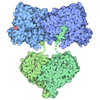[English] 日本語
 Yorodumi
Yorodumi- PDB-1k1e: Structure Of the cobalt-bound form of the deoxy-D-mannose-octulos... -
+ Open data
Open data
- Basic information
Basic information
| Entry | Database: PDB / ID: 1k1e | ||||||
|---|---|---|---|---|---|---|---|
| Title | Structure Of the cobalt-bound form of the deoxy-D-mannose-octulosonate 8-phosphate phosphatase (YrbI) From Haemophilus Influenzae (HI1679) | ||||||
 Components Components | deoxy-D-mannose-octulosonate 8-phosphate phosphatase | ||||||
 Keywords Keywords | HYDROLASE / HI1679 / structural genomics / KDO 8-P phosphatase / Structure 2 Function Project / S2F | ||||||
| Function / homology |  Function and homology information Function and homology information3-deoxy-manno-octulosonate-8-phosphatase / 3-deoxy-manno-octulosonate-8-phosphatase activity / lipopolysaccharide biosynthetic process / metal ion binding Similarity search - Function | ||||||
| Biological species |  Haemophilus influenzae Rd (bacteria) Haemophilus influenzae Rd (bacteria) | ||||||
| Method |  X-RAY DIFFRACTION / X-RAY DIFFRACTION /  SYNCHROTRON / SYNCHROTRON /  MOLECULAR REPLACEMENT / Resolution: 1.67 Å MOLECULAR REPLACEMENT / Resolution: 1.67 Å | ||||||
 Authors Authors | Lim, K. / Herzberg, O. / Structure 2 Function Project (S2F) | ||||||
 Citation Citation |  Journal: Proteins / Year: 2002 Journal: Proteins / Year: 2002Title: From structure to function: YrbI from Haemophilus influenzae (HI1679) is a phosphatase. Authors: Parsons, J.F. / Lim, K. / Tempczyk, A. / Krajewski, W. / Eisenstein, E. / Herzberg, O. | ||||||
| History |
| ||||||
| Remark 400 | COMPOUND THE FUNCTION OF THE PROTEIN WAS ASSIGNED INDEPENDENTLY BY THE WOODARD GROUP: ESCHERICHIA ...COMPOUND THE FUNCTION OF THE PROTEIN WAS ASSIGNED INDEPENDENTLY BY THE WOODARD GROUP: ESCHERICHIA COLI YRBI IS 3-DEOXY-D-MANNO-OCTULOSONATE 8-PHOSPHATE PHOSPHATASE, WU J, WOODARD RW; J BIOL CHEM. 2003 278:18117-2. |
- Structure visualization
Structure visualization
| Structure viewer | Molecule:  Molmil Molmil Jmol/JSmol Jmol/JSmol |
|---|
- Downloads & links
Downloads & links
- Download
Download
| PDBx/mmCIF format |  1k1e.cif.gz 1k1e.cif.gz | 437.6 KB | Display |  PDBx/mmCIF format PDBx/mmCIF format |
|---|---|---|---|---|
| PDB format |  pdb1k1e.ent.gz pdb1k1e.ent.gz | 352.7 KB | Display |  PDB format PDB format |
| PDBx/mmJSON format |  1k1e.json.gz 1k1e.json.gz | Tree view |  PDBx/mmJSON format PDBx/mmJSON format | |
| Others |  Other downloads Other downloads |
-Validation report
| Summary document |  1k1e_validation.pdf.gz 1k1e_validation.pdf.gz | 569.3 KB | Display |  wwPDB validaton report wwPDB validaton report |
|---|---|---|---|---|
| Full document |  1k1e_full_validation.pdf.gz 1k1e_full_validation.pdf.gz | 606 KB | Display | |
| Data in XML |  1k1e_validation.xml.gz 1k1e_validation.xml.gz | 91.7 KB | Display | |
| Data in CIF |  1k1e_validation.cif.gz 1k1e_validation.cif.gz | 127.8 KB | Display | |
| Arichive directory |  https://data.pdbj.org/pub/pdb/validation_reports/k1/1k1e https://data.pdbj.org/pub/pdb/validation_reports/k1/1k1e ftp://data.pdbj.org/pub/pdb/validation_reports/k1/1k1e ftp://data.pdbj.org/pub/pdb/validation_reports/k1/1k1e | HTTPS FTP |
-Related structure data
| Related structure data |  1j8dSC S: Starting model for refinement C: citing same article ( |
|---|---|
| Similar structure data | |
| Other databases |
- Links
Links
- Assembly
Assembly
| Deposited unit | 
| ||||||||
|---|---|---|---|---|---|---|---|---|---|
| 1 | 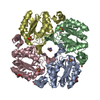
| ||||||||
| 2 | 
| ||||||||
| 3 | 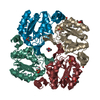
| ||||||||
| 4 | 
| ||||||||
| 5 | 
| ||||||||
| Unit cell |
| ||||||||
| Details | The biological unit is a tetramer. The asymmetric unit contains three tetramers |
- Components
Components
-Protein , 1 types, 12 molecules ABCDEFGHIJKL
| #1: Protein | Mass: 19455.283 Da / Num. of mol.: 12 Source method: isolated from a genetically manipulated source Source: (gene. exp.)  Haemophilus influenzae Rd (bacteria) / Species: Haemophilus influenzae / Strain: KW20 / Gene: HI1679 / Plasmid: PDEST17-HI1679 / Production host: Haemophilus influenzae Rd (bacteria) / Species: Haemophilus influenzae / Strain: KW20 / Gene: HI1679 / Plasmid: PDEST17-HI1679 / Production host:  References: UniProt: P45314, Hydrolases; Acting on ester bonds; Phosphoric-monoester hydrolases |
|---|
-Non-polymers , 6 types, 1465 molecules 



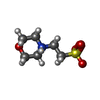






| #2: Chemical | ChemComp-CO / #3: Chemical | ChemComp-HG / #4: Chemical | ChemComp-SO4 / #5: Chemical | ChemComp-GOL / #6: Chemical | #7: Water | ChemComp-HOH / | |
|---|
-Experimental details
-Experiment
| Experiment | Method:  X-RAY DIFFRACTION / Number of used crystals: 1 X-RAY DIFFRACTION / Number of used crystals: 1 |
|---|
- Sample preparation
Sample preparation
| Crystal | Density Matthews: 2.18 Å3/Da / Density % sol: 43.57 % |
|---|---|
| Crystal grow | Temperature: 295 K / Method: vapor diffusion, hanging drop / pH: 6.5 Details: 1.5 M ammonium sulfate, 0.1 M MES, 10 mM CoCl2. Crystal soaked with 1mM Hg acetate for 3 days. 10% glycerol added for flash-cooling, pH 6.5, VAPOR DIFFUSION, HANGING DROP, temperature 295K |
-Data collection
| Diffraction | Mean temperature: 100 K |
|---|---|
| Diffraction source | Source:  SYNCHROTRON / Site: SYNCHROTRON / Site:  NSLS NSLS  / Beamline: X12C / Wavelength: 0.95 Å / Beamline: X12C / Wavelength: 0.95 Å |
| Detector | Type: BRANDEIS / Detector: CCD / Date: Aug 20, 2000 |
| Radiation | Protocol: SINGLE WAVELENGTH / Monochromatic (M) / Laue (L): M / Scattering type: x-ray |
| Radiation wavelength | Wavelength: 0.95 Å / Relative weight: 1 |
| Reflection | Resolution: 1.67→50 Å / Num. all: 199616 / Num. obs: 199616 / % possible obs: 86.1 % / Observed criterion σ(F): 0 / Observed criterion σ(I): 0 / Redundancy: 3.3 % / Biso Wilson estimate: 19 Å2 / Rmerge(I) obs: 0.12 / Net I/σ(I): 11.6 |
| Reflection shell | Resolution: 1.67→1.75 Å / Rmerge(I) obs: 0.213 / % possible all: 49.3 |
- Processing
Processing
| Software |
| ||||||||||||||||||||
|---|---|---|---|---|---|---|---|---|---|---|---|---|---|---|---|---|---|---|---|---|---|
| Refinement | Method to determine structure:  MOLECULAR REPLACEMENT MOLECULAR REPLACEMENTStarting model: HI1679 (PDB code 1j8d) Resolution: 1.67→20 Å / Cross valid method: THROUGHOUT / σ(F): 2 / Stereochemistry target values: Engh & Huber
| ||||||||||||||||||||
| Displacement parameters | Biso mean: 21 Å2 | ||||||||||||||||||||
| Refinement step | Cycle: LAST / Resolution: 1.67→20 Å
| ||||||||||||||||||||
| Refine LS restraints |
| ||||||||||||||||||||
| LS refinement shell | Resolution: 1.67→1.75 Å / Rfactor Rfree: 0.269 / Rfactor Rwork: 0.206 |
 Movie
Movie Controller
Controller


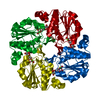
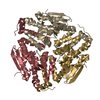
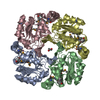

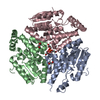

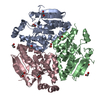

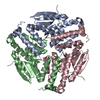
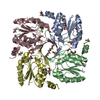
 PDBj
PDBj










